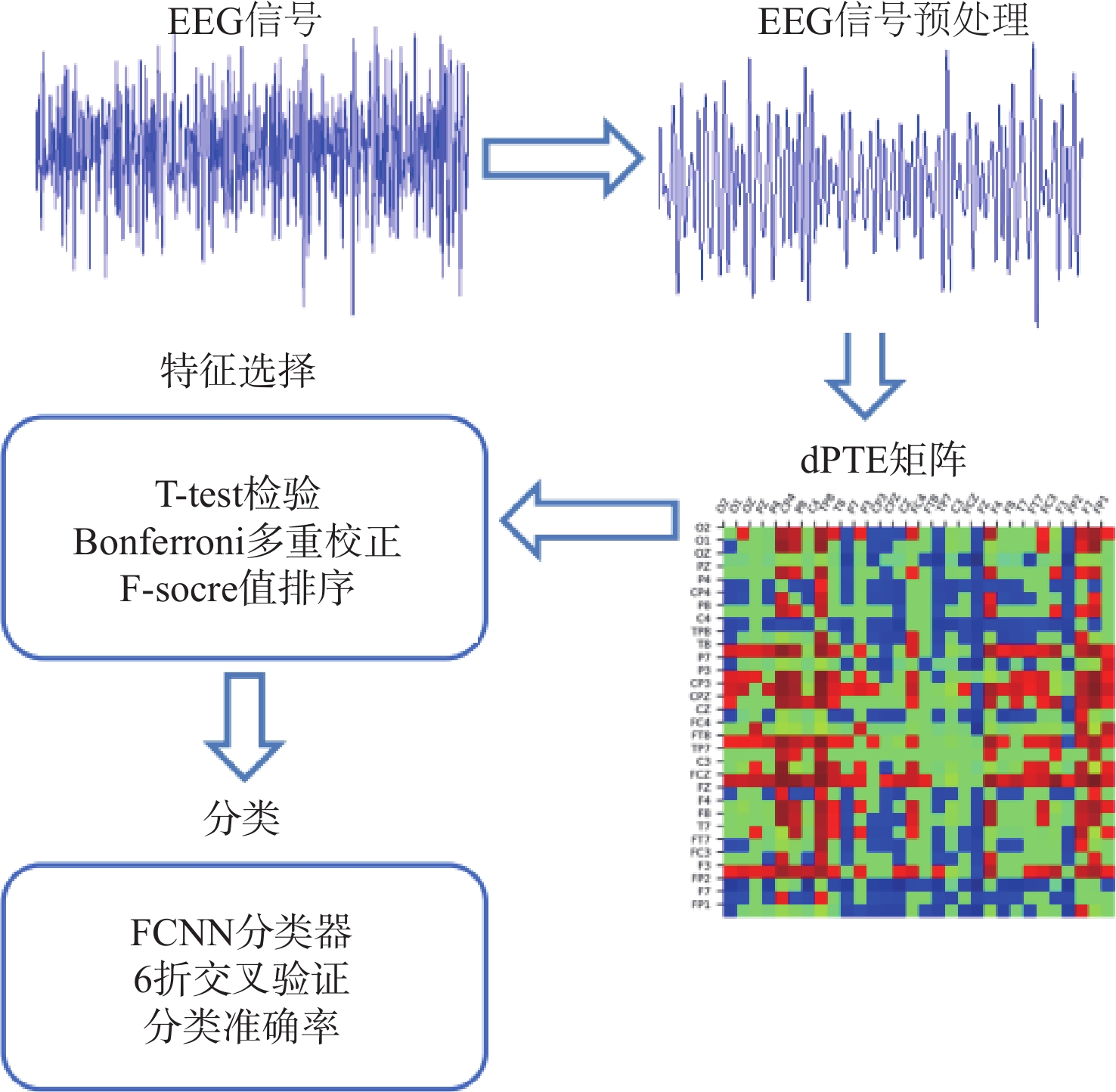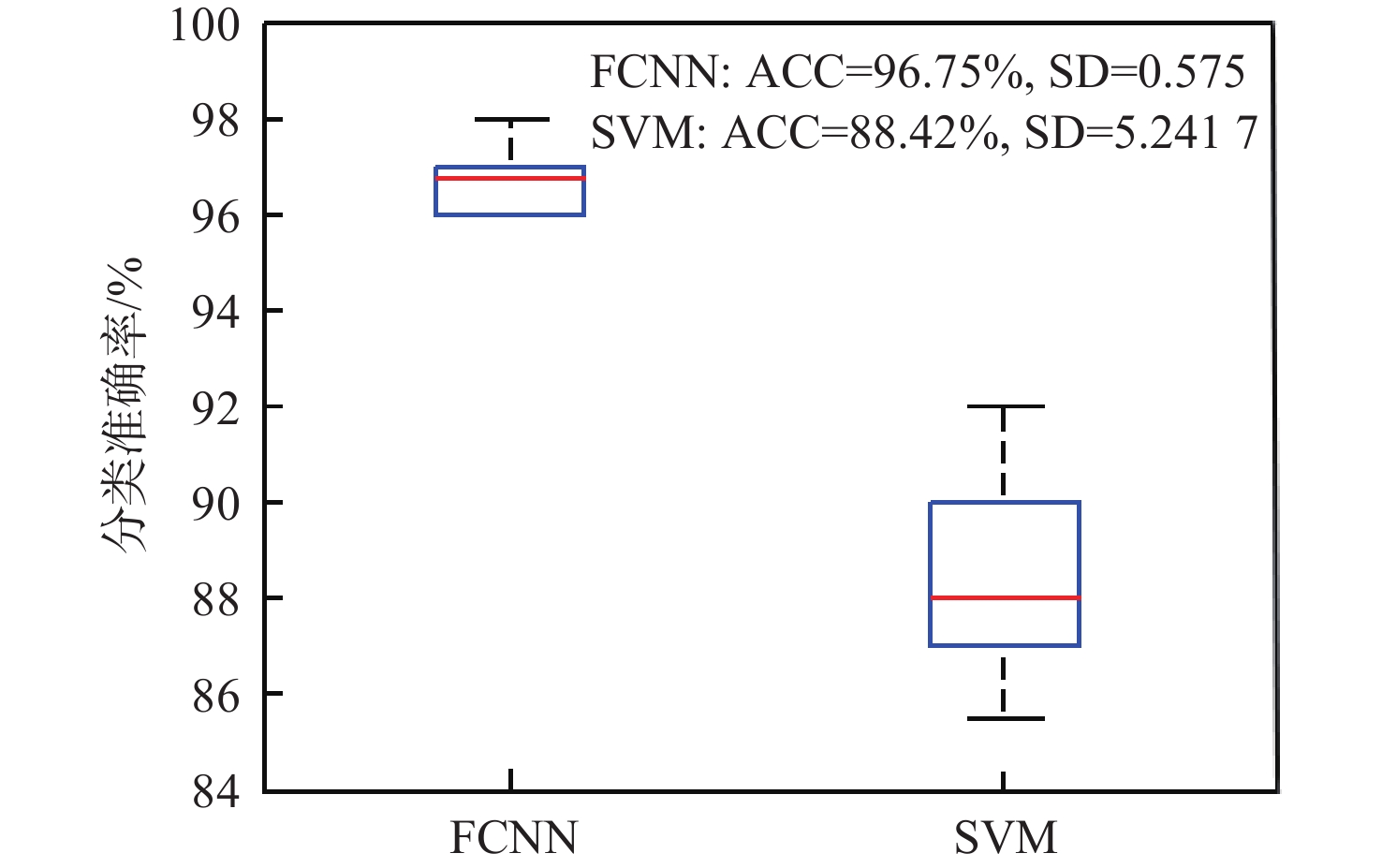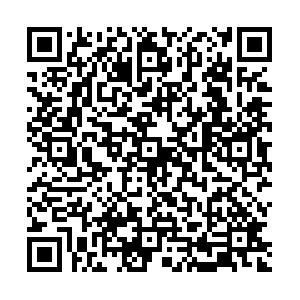-
摘要:
说谎是复杂的认知过程,其执行控制功能需要不同脑区的共同参与,相关研究证实了这些脑区之间存在相互作用。针对当前脑电信号特征提取方法有限及谎言机制尚不明确的问题,利用相位传递熵构建了谎言实验过程中脑电信号的脑网络,并分析了诚实组和说谎组不同脑区间的效应连接差异。采用标准的三刺激实验模式对60名受试者进行说谎检测实验,同步采集所有受试者的脑电信号并进行预处理;利用相位传递熵构建效应连接矩阵,通过统计方法对矩阵中的每一条边进行2组间的熵值差异分析,选取具有显著性差异的导联对上的熵值作为全连接神经网络的分类特征,结果显示,分类准确率为96.75%,说明相位传递熵指标可以有效区分说谎者和诚实者2类人群的脑电信号;对2类人群大脑功能网络的分析结果显示,与诚实者相比,说谎类人群的额叶、顶叶和颞叶之间存在更强的信息流动,表明说谎行为需要协调和使用更多的大脑资源。研究结果有助于揭示说谎状态下大脑的神经活动机制。
Abstract:Lying is a complex cognitive process whose executive function requires the participation of different brain regions. And the interaction between these brain regions has been confirmed by related research. In view of the problems of limited current EEG signal feature extraction methods and the unclear psychological mechanism of lying, we constructed EEG signals-based brain networks by phase transfer entropy during the lie experiment, and we have analyzed the effective connectivity between different brain regions in the honest group and the lying group. First, the standard three-stimulus experiment was used to conduct a lying detection experiment on 60 subjects. The EEG signals of all subjects were collected simultaneously and preprocessed.Then, the phase transfer entropy was used to construct the effective connectivity matrix. Subsequently, the statistical method was used to analyze the entropy value difference between the two groups of each edge in the matrix, and the electrode pairs with significant differences in entropy value were selected as the classification features of the fully connected neural network. The result shows that the classification accuracy rate is 96.75%, indicating that it is effective to use phase transfer entropy index to distinguish the EEG signals of the liar and the honest. Finally, the brain function network of the two groups of people was analyzed. The results show that compared with honest people, there is a stronger flow of information between the frontal, parietal and temporal lobes of the liar, indicating that deception requires coordination and utilization of more brain resources. The above analysis results will help reveal the brain’s neural activity mechanism in a lying state.
-
Key words:
- EEG /
- lie detection /
- effective connectivity /
- phase transfer entropy /
- fully connected neural network /
- brain networks
-
表 1 具有显著性差异的6个有向电极对平均dPTE值统计分析结果
Table 1. Statistical analysis results of average dPTE of 6 directed electrode pairs with significant differences
电极对 平均dPTE值 x y 说谎组 诚实组 P4 T8 0.6115 0.4670 P4 Pz 0.5776 0.4740 FCz F7 0.3604 0.5331 FP2 T8 0.5668 0.4227 P4 FT8 0.6061 0.4620 F7 FT8 0.5963 0.4818 表 2 电极及其相应的投射皮层区域
Table 2. Electrodes and their corresponding projection cortical areas
电极 Brodmann分区 脑区名称 P4 顶叶 R Inferior parietal Gyrus (R-IPG) 后顶回 Pz M Superior parietal Lobe(M-SPL) 顶上小叶 F7 额叶 L Inferior frontal Gyrus (L-IFG) 额下回 FP2 R Superior frontal Gyrus (R-SFG) 额上回 FCz M Superior frontal Gyrus (M-SFG) 额上回 T8 颞叶 R Middle temporal Gyrus (R-MTG) 颞中回 FT8 R Superior temporal Gyrus (R-STG) 颞上回 注:R表示右; L表示左;M表示中。 -
[1] TURRI A, TURRI J. The truth about lying[J]. Cognition:International Journal of Cognitive Psychology, 2015, 138: 161-168. doi: 10.1016/j.cognition.2015.01.007 [2] GÜNTER K. Behavioral correlates of statement credibility: Theories, paradigms, and results[M]. Berlin: Springer, 1989: 281-282. [3] TOMASH J, REED P. The generalization of a conditioned response to deception across the public/private barrier[J]. Learning and Motivation, 2013, 44(3): 196-203. doi: 10.1016/j.lmot.2012.12.001 [4] GAO J F, YAN X G, SUN J C, et al. Denoised P300 and machine learning-based concealed information test method[J]. Computer Methods and Programs in Biomedicine, 2011, 104(3): 410-417. doi: 10.1016/j.cmpb.2010.10.002 [5] 彭丝雨, 周到, 张家琦, 等. 基于互信息的脑网络及测谎研究[J]. 电子学报, 2019, 47(7): 1551-1556. doi: 10.3969/j.issn.0372-2112.2019.07.021PENG S Y, ZHOU D, ZHANG J Q, et al. Research on mutual information-based brain network and lie detection[J]. Acta Electronica Sinica, 2019, 47(7): 1551-1556(in Chinese). doi: 10.3969/j.issn.0372-2112.2019.07.021 [6] BABLANI A, EDLA D R, TRIPATHI D, et al. An efficient concealed information test: EEG feature extraction and ensemble classification for lie identification[J]. Machine Vision and Applications, 2019, 30(5): 813-832. doi: 10.1007/s00138-018-0950-y [7] WANG H, CHANG W, ZHANG C. Functional brain network and multichannel analysis for the P300-based brain computer interface system of lying detection[J]. Expert Systems with Applications, 2016, 53: 117-128. doi: 10.1016/j.eswa.2016.01.024 [8] WANG Y, CHUN N W, SIONG N K, et al. An electroencephalography network and connectivity analysis for deception in instructed lying tasks[J]. Plos One, 2015, 10(2): e0116522. doi: 10.1371/journal.pone.0116522 [9] KOHAN M D, NASRABADI A M, SHARIFI A, et al. Interview based connectivity analysis of EEG in order to detect deception[J]. Medical Hypotheses, 2020, 136: 109517. doi: 10.1016/j.mehy.2019.109517 [10] LI M, LUO X Y, YANG J F, et al. Applying a locally linear embedding algorithm for feature extraction and visualization of MI-EEG[J]. Journal of Sensors, 2016, 2016: 7481946. [11] MURIEL L A, FELIX S, SATU P, et al. Phase transfer entropy: A novel phase-based measure for directed connectivity in net-works coupled by oscillatory interactions[J]. Neuroimage, 2014, 85: 853-872. doi: 10.1016/j.neuroimage.2013.08.056 [12] HILLEBRAND A, TEWARIE P, DELLEN E V, et al. Direction of information flow in large-scale resting-state networks is frequency-dependent[J]. Proceedings of the National Academy of Sciences, 2016, 113(14): 3867-3872. doi: 10.1073/pnas.1515657113 [13] MEENAKSHI D, EDWIN V D, LOTTE B, et al. EEG-directed connectivity from posterior brain regions is decreased in dementia with Lewy bodies: A comparison with Alzheimer’s disease and controls[J]. Neurobiology of Aging, 2016, 41: 122-129. doi: 10.1016/j.neurobiolaging.2016.02.017 [14] FATEMEH H, MARYAM M, REZA R. Graph theory analysis of directed functional brain networks in major depressive disorder based on EEG signal[J]. Journal of Neural Engineering, 2020, 17(2): 026010. doi: 10.1088/1741-2552/ab7613 [15] VICENTE R, WIBRAL M, LINDNER M, et al. Transfer entropy—A model-free measure of effective connectivity for the neurosciences[J]. Journal of Computational Neuroscience, 2011, 30(1): 45-67. doi: 10.1007/s10827-010-0262-3 [16] EMARA H M, ELWEKEIL M, TAHA T E, et al. Hilbert transform and statistical analysis for channel selection and epileptic seizure prediction[J]. Wireless Personal Communications, 2021, 116(2): 3371-3395. [17] CHOWDHURY M S N, DUTTA A, ROBISON M K, et al. Deep neural network for visual stimulus-based reaction time estimation using the periodogram of single-trial EEG[J]. Sensors, 2020, 20(21): 6090. doi: 10.3390/s20216090 [18] ARASTEH A, MORADI M H, JANGHORBANI A. A novel method based on empirical mode decomposition for P300-based detection of deception[J]. IEEE Transactions on Information Forensics and Security, 2016, 11(11): 2584-2593. doi: 10.1109/TIFS.2016.2590938 [19] VDAS D, DATTA S, BHATTACHARJEE T, et al. Eliminating individual bias to improve stress detection from multimodal physiological data[C]//2018 40th Annual International Conference of the IEEE Engineering in Medicine and Biology Society (EMBC). Piscataway: IEEE Press, 2018: 5753-5758. [20] JAMES G, WITTEN D, HASTIE T, et al. An introduction to statistical learning: With applications in R[M]. Berlin: Springer, 2013: 176-177. [21] GAO J F, LANG L, YANG Y, et al. A novel concealed information test method based on independent component analysis and support vector machine[J]. Clinical EEG and Neuroscience, 2012, 43(1): 54-63. doi: 10.1177/1550059411428715 [22] KOESSLER L, MAILLARD L, BENHADID A, et al. Automated cortical projection of EEG sensors: Anatomical correlation via the international 10-10 system[J]. Neuroimage, 2009, 46(1): 64-72. doi: 10.1016/j.neuroimage.2009.02.006 [23] XIA M R, WANG J H, HE Y. BrainNet Viewer: A network visualization tool for human brain connectomics[J]. Plos One, 2013, 8(7): e68910. doi: 10.1371/journal.pone.0068910 [24] GANIS G, ROSENFELD J P, MEIXNER J, et al. Lying in the scanner: Covert countermeasures disrupt deception detection by functional magnetic resonance imaging[J]. Neuroimage, 2011, 55(1): 312-319. doi: 10.1016/j.neuroimage.2010.11.025 [25] BORST J P, ANDERSON J R. Using model-based functional MRI to locate working memory updates and declarative memory retrievals in the fronto-parietal network[J]. Proceedings of the National Academy of Sciences of the United States of America, 2013, 110(5): 1628-1633. doi: 10.1073/pnas.1221572110 [26] CHRIST S E, ESSEN D C V, WATSON J M, et al. The contributions of prefrontal cortex and executive control to deception: Evidence from activation likelihood estimate meta-analyses[J]. Cerebral Cortex, 2009, 19(7): 1557-1566. [27] CHAN C, CHETWYN C H, SUN D, et al. Unfolding the spatial and temporal neural processing of lying about face familiarity[J]. Cerebral Cortex, 2015, 25(4): 927-936. doi: 10.1093/cercor/bht284 [28] HEBART M N, HESSELMANN G. What visual information is processed in the human dorsal stream?[J]. Journal of Neuroscience the Official Journal of the Society for Neuroscience, 2012, 32(24): 8107-8109. doi: 10.1523/JNEUROSCI.1462-12.2012 [29] KARTON I, BACHMANN T. Disrupting dorsolateral prefrontal cortex by rTMS reduces the P300 based marker of deception[J]. Brain and Behavior, 2017, 7(4): e00656. doi: 10.1002/brb3.656 -








 下载:
下载:








